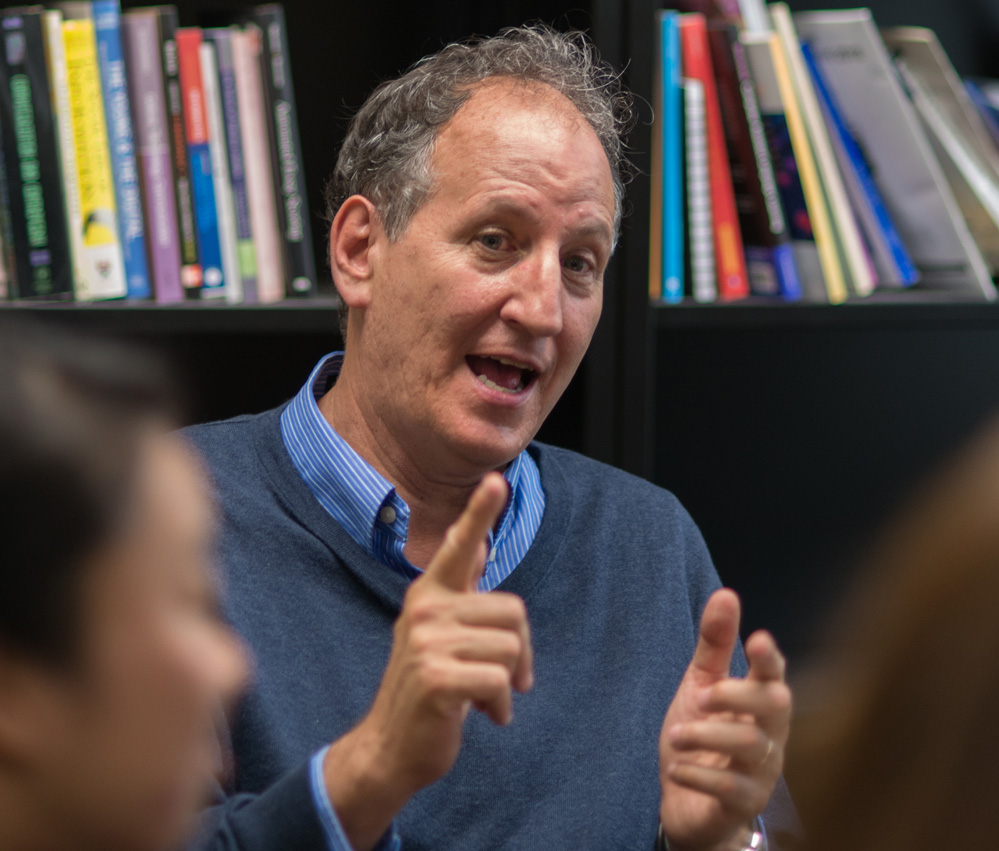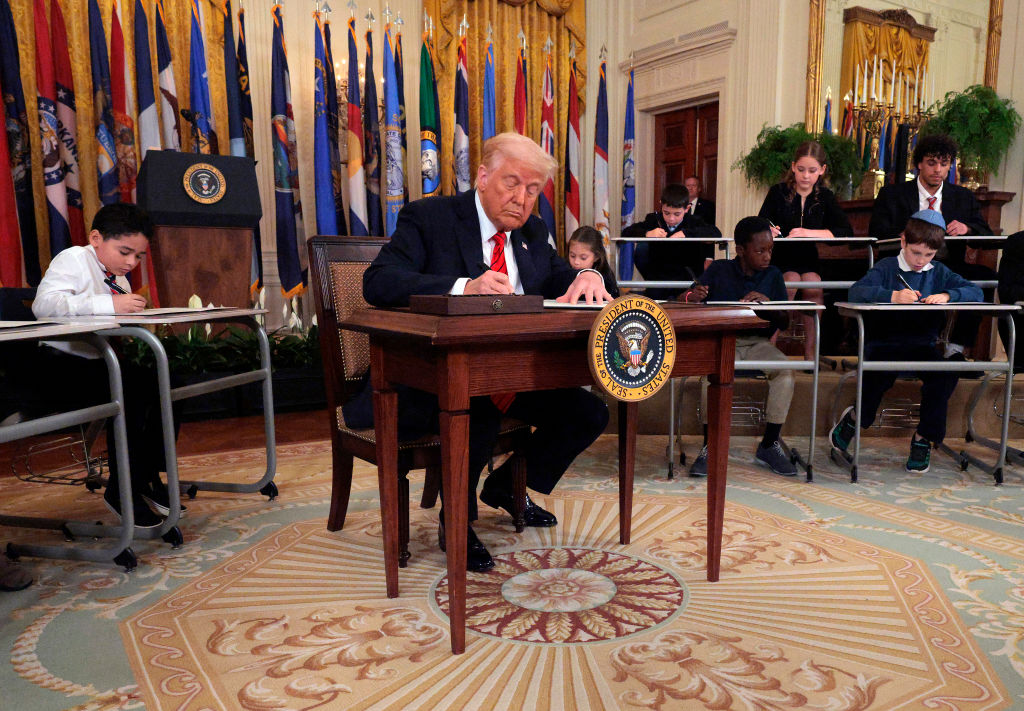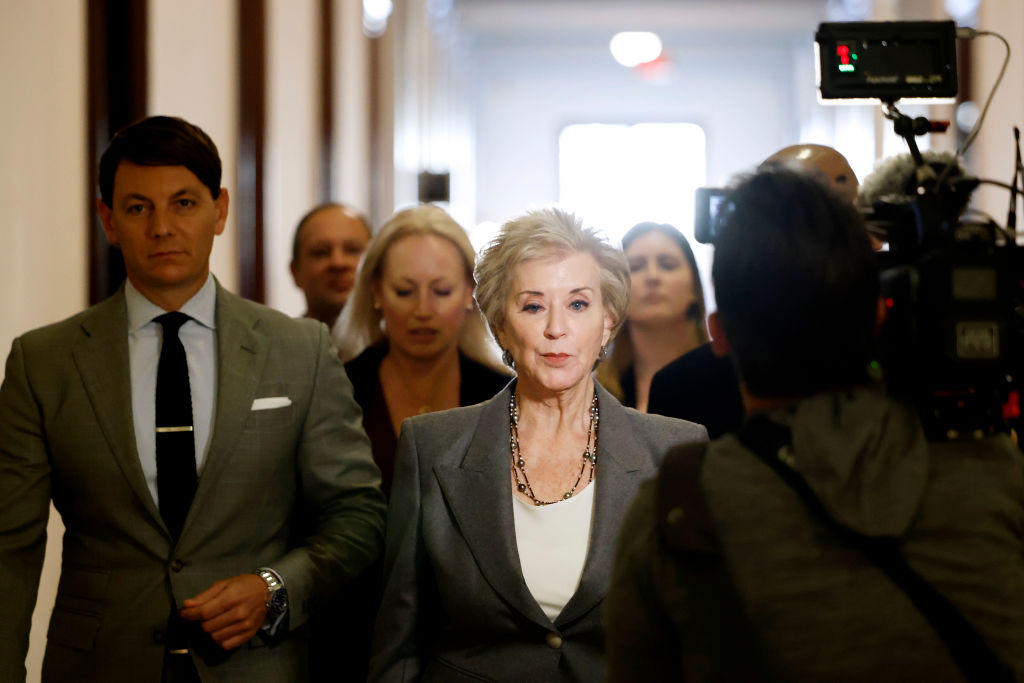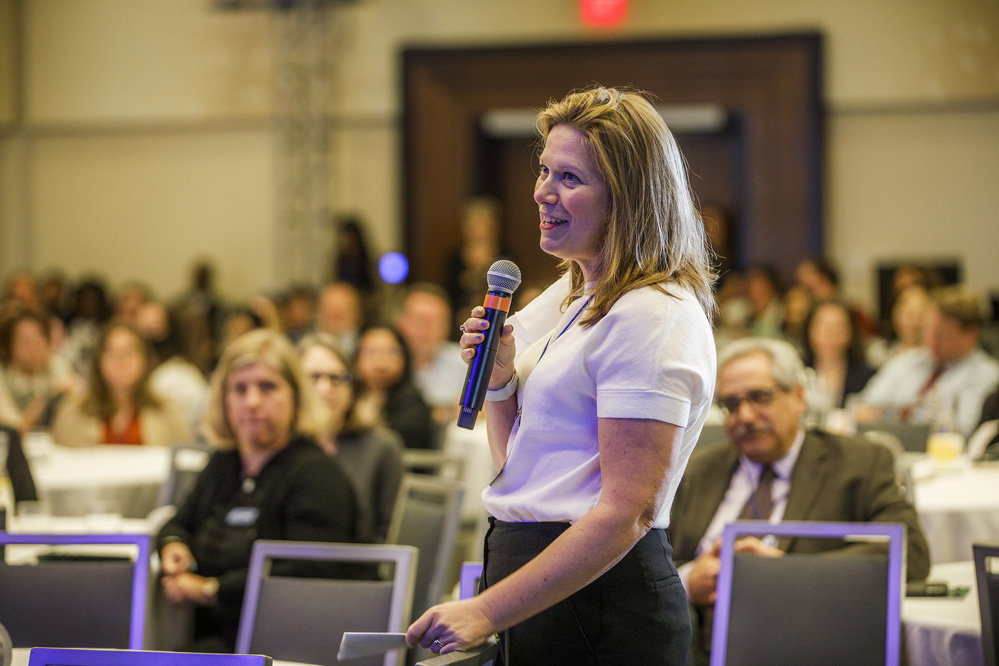‘Back to the Dark Ages’: Education Research Staggered by Trump Cuts
With contracts severed and grants rescinded, experts say Washington’s hit to K–12 research will set back the field for years.

Get stories like this delivered straight to your inbox. Sign up for The 74 Newsletter
The Trump administration’s dramatic strike at U.S. education research had been underway for months before Mark Warschauer learned that his own work would become a casualty.
The renowned education professor at the University of California, Irvine, had spent years studying how the newest technologies can be used to improve English language instruction. His latest efforts, funded through the National Science Foundation, aimed to create a series of bilingual Spanish-English e-books that would use artificial intelligence to guide young readers through each text and prompt them with questions.
But in the last week of April, he learned that the supporting grant for the project had been cancelled, along with hundreds of others issued by NSF’s education division, at the direction of Elon Musk’s Department of Government Efficiency. The substantial majority of the cuts, amounting to hundreds of millions of dollars, targeted education studies like those conducted at Irvine’s Digital Learning Lab, which Warschauer directs.
The professor grew more concerned as he considered the possible consequences of DOGE’s moves. He spent the last few years helping design programs that fostered parent-child reading within families of English learners, even partnering with PBS Kids on a set of AI-powered videos that measurably improved students’ science knowledge. The results had been impressive. But without federal dollars, they couldn’t realistically be sustained, let alone expanded.
“I could go from having a well-funded research lab — one that supported a lot of graduate students and post-docs, and had a very ambitious research agenda — to pretty much drying up in a few years and needing to lay off everyone working for me,” Warschauer reflected.
His worries have echoed throughout the nation’s sprawling education research infrastructure since February, when the administration severed scores of contracts through the Institute of Education Sciences, the principal knowledge-gathering body within the U.S. Department of Education. Within weeks, further announcements were made of mass layoffs totalling half the department’s manpower, including roughly 90 percent of the IES staff. Questions even arose around the future of the National Assessment of Educational Progress (NAEP), the only coast-to-coast benchmark of student achievement.

Several experts told The 74 that the diminution of both staffing and resources leaves the core functions of K–12 research in doubt. Reduced support for the What Works Clearinghouse, an online library promoting evidence-based practices in education, could leave district leaders unequipped to navigate the billion-dollar world of school-based products and services. Deferred updates to long-running data sets may prove a serious hindrance to experts investigating key questions like school choice and early literacy. Uncertain employment conditions have already driven established professionals from the field, even while interrupting the early-career trajectories of the next generation of scholars.
Among the motivations cited for the campaign is the charge that Washington has too often funded activist researchers promoting “woke” ideological content. Warschauer said that while his professional interests resulted partially from his past service as an ESL teacher, he rejected the precepts of critical theory and simply wanted to pursue better learning outcomes for struggling kids.
“My research is about having high standards of education for our poor, our underserved, and those who are not succeeding, and helping them succeed better,” he said. “To me, that’s not a woke agenda; it’s something that, until the last five years, every Republican politician in the country has agreed with.”
The administration has tweaked some aspects of its strategy, bringing in new leaders to oversee the future of the department’s research efforts and reviving a portion of the contracts it had halted. But especially following last week’s Supreme Court ruling, which formally authorized the widespread reductions in force while other litigation is being considered, many now believe the end is in sight.
Cara Jackson served as president of the Association of Education Finance and Policy, one of the foremost professional organizations for education researchers, when the unwinding began. The consortium is now pursuing legal action against the administration, alleging that its actions violate laws governing how federal agencies may behave. She fears that, whatever the outcome of that litigation, the attempt to sweep aside decades of systems and collaborations between government, universities, and private actors will severely limit America’s insights into what, and whether, its children are actually learning.
The biggest thing that frustrates me is that we paid a lot of money for these practice guides to be created, and they're not going to go into the world now.
Cara Jackson, former president, Association of Education Finance and Policy
“The entire time IES has existed, it has done a lot to advance the field and the quality of research that is being produced,” she said. “It just feels like we’re going back into the dark ages.”
A retreat from ‘what works’
Jackson’s own life was upended by the events of the last few months. She was laid off in March when her employer, the research and consulting company Abt Global, significantly scaled back its work in education evaluations.
Abt is part of the archipelago of private firms that have long partnered with the federal government, many of which saw multi-year, eight-figure contracts terminated by IES this winter. The commitments ranged widely in size and focus — from a $430,000 commitment to collect responses to a school crime survey to a $43 million bid to implement programs preparing disabled students for success after high school.
Much of Jackson’s time was spent developing the What Works Clearinghouse’s line of Practice Guides, which distill the findings of complex social science into digestible recommendations for classroom teachers and district leaders. Thirty of the guides have been published since 2007, with several more in the pipeline earlier this year — including proposals for texts on chronic absenteeism and student behavior problems, two of the biggest issues facing schools in the post-COVID era.

Those projects may be indefinitely postponed, if not scuppered entirely, by both the reduction of the Institute’s contracts and harrowing of its workforce.
“The biggest thing that frustrates me as a taxpayer is that we paid a lot of money for these practice guides to be created, and they’re not going to go into the world now because they got abruptly stopped,” Jackson said.
Betsy Wolf, a research scientist who was among the throngs of departing IES employees, had been working on a project that attempted to apply the findings from cognitive science to inform STEM teachers. She said she was pessimistic about the prospects of reconstituting the work that had already been done into some future product, especially in the absence of so many staffers.
“We lost computer access, and we couldn’t even email people externally,” Wolf recalled. “As far as I’m aware, the department didn’t get back any of the stuff it paid for. And you couldn’t just get someone in to pick it back up because it may not even exist right now.”
The department didn't get back any of the stuff it paid for.
Betsy Wolf, former research scientist, Institute of Education Sciences
The Clearinghouse is not without critics, including prominent commentators who have argued that its guides don’t offer suggestions in language that teachers can easily understand. Others have alleged that past publications have misinterpreted research findings or classified programs incorrectly.
But the need for stronger evidence in teaching methods has been highlighted over the past few years by a series of controversies related to shoddy or questionable instruction. Families in San Francisco have fiercely resisted a proposal that would delay the teaching of algebra I until the ninth grade to address achievement gaps — a move that didn’t achieve its stated goals, a later analysis found — while districts around the country have spent billions of dollars on reading curricula derived from the discredited “whole language” theory of literacy.
Some observers fret that progress may be threatened in areas where K–12 leaders have used existing research to dramatically improve outcomes. In February, the department eliminated over $300 million in contracts with 10 Regional Education Labs, including one that partnered with Mississippi to lead a dramatic improvement in the state’s persistently low reading performance. [The Trump administration later backtracked on those cuts as part of a broader reversal, according to a June legal filing: Though not required by the court, the department announced that it would rehire several dozen employees and restart roughly one-fifth of the contracts that had previously been suspended.]
Elizabeth Tipton is a statistician at Northwestern University who also serves as the director of the Society for Research on Educational Effectiveness, another professional organization suing the administration over its cuts. If anything, she said, Washington should endeavor to strengthen the powers of agencies like IES to more strictly regulate a marketplace for school materials and technology that often provide no value. Without an entity to function in the manner of the Food and Drug Administration, the world of K–12 products resembles that of herbal supplements, she argued.
“I don’t understand how it’s woke, I don’t understand why it’s inefficient, I don’t understand why DOGE would be against it, I just don’t understand the argument,” Tipton said. “It’s actually good for kids to understand what works and to invest in that science.”
Lost data
As it evaluates various policies and classroom interventions, the government also collects huge troves of data on students’ backgrounds, the kinds of schooling they access, and their success both during and after their time as students. The progress of those long-running data sets, mostly housed within the 158-year-old National Center for Education Statistics, have also been stalled by the events of the last few months.
We were about to get a look at students in the first post-pandemic class of kindergartners. You cannot have a story like that in the future if we don’t have that data.
Rachel Dinkes, Knowledge Alliance
Rachel Dinkes is the president and CEO of the Knowledge Alliance, the industry group representing private research organizations like Abt Global, the American Institutes for Research, and the Educational Testing Service. In an interview, she sketched out an uncertain future for some of the biggest education research undertakings of the last few decades
“We heard Sec. McMahon say that her plan is to unwind the mission of the Department of Education,” Dinkes said. “That leads to serious questions about where these research programs will turn to.”
A career statistician and research analyst, she ticked off a laundry list of data collections affected by the Trump administration’s cuts. A pilot program to design new student assessments — part of states’ bargain with Washington to enjoy more autonomy after the end of the No Child Left Behind Act in 2015 — was at the center of a $3.6 million contract that was scrapped after more than five years of work. Over $48 million in funding for the latest iteration of the National Postsecondary Student Aid Study, which examines how college students finance their education, was also tossed; the insights generated by the survey would have very likely informed future legislation on student borrowing and federal aid, Dinkes said.
But perhaps the biggest hit delivered to NCES data came with the sweeping cut to the Early Child Longitudinal Study program, which has conducted four major, ongoing studies of children from the earliest years of schooling. The latest addition to the initiative was designed to track the progress of the kindergarten class of 2022–23, a cohort that absorbed much of the social and academic stresses of the COVID era.
“We were about to get a look at students in the first post-pandemic class of kindergartners and see what they can do,” Dinkes said. “You cannot have a story like that in the future if we don’t have that data.”

A spokesman for the department did not respond to a request for comment on the possible effects of Trump’s flurry of cuts. But McMahon has stated publicly that her agency’s dismantling was necessary, pointing to its time in existence as “an era of stagnation and decline in student achievement.” [In fact, long-term scores in math and literacy have been on an upward trajectory since the department’s creation in 1980, though the learning loss inflicted by COVID erased much of that progress.]
Mark Chin, a professor of education policy at Vanderbilt University, intended to use his school’s access to ECLS files to assess the impact of school choice programs. Much of the current empirical work on charter or voucher policies is built on information gathered by school districts or state education agencies, which typically identify student demographics, special education status, and socioeconomic status. But the federal data incorporates far richer observations on household structure and parent engagement, including live interviews and survey responses with caregivers.
If you've got results, but you can't put them out there, it's not being seen by policymakers who really need that information.
Mark Chin, Vanderbilt University
With the benefit of that perspective, Chin had hoped to offer a more detailed investigation of the possible differences between families who participate in choice schemes versus those who simply attend their district public schools.That work is currently stalled.
So too, he added, are countless papers constructed through the use of federal resources, which are usually submitted to department staffers for a once-over before they are released in order to assure both quality control and protect student privacy. The mass layoffs in March could prevent some valuable discoveries from finding their way to the public square.
“In order for this research to become public, it needs to be reviewed by IES,” he said. “Given the state of IES’s staffing, that’s basically not feasible. If you’ve got results, but you can’t put them out there, it’s not being seen by policymakers who really need that information.”
‘They’re never coming back’
As spring has turned to summer, a few promising signs have emerged for scholars whose research was affected by the wave of cuts.
At the end of June, UC Irvine’s Warschauer was notified that his grants from the National Science Foundation had been reinstated. The reversal was achieved through a class action lawsuit filed by six UC professors who alleged that grants previously awarded through the NSF, the National Endowment for the Humanities, and the Environmental Protection Agency had been unlawfully slashed. A district judge issued an injunction requiring the funds to be restored, though the ruling can be appealed in a higher court.
In an email, Warschauer said he was “thrilled” with the result, while observing that it would almost certainly be harder to gain future support than it was to revive existing grants.
“This doesn’t make me any more optimistic about new grant opportunities — those are easier (and more justifiable) to control than cancelling grants that people already have,” he wrote. “So the bottom line is that the future of educational research is still very much in jeopardy.”
Under McMahon’s leadership, the Department of Education has taken some steps that have the potential to solidify its future support for research. In an interview with The 74’s Greg Toppo, the secretary vowed to keep in place the NAEP exam. A veteran IES staffer has been named the acting commissioner of NCES, and respected researcher Amber Northern was tapped to serve as McMahon’s senior advisor.
But even with the dust still settling after months of firings, the toll on the department has already been huge. IES’s headcount now numbers fewer than 20 employees, while NCES has reportedly been reduced to just three. Last Monday’s Supreme Court ruling allowed the president to implement those layoffs, rejecting a lower court’s motion to block them.
Other legal challenges to prior cuts haven’t made headway yet. In June, a district court judge denied AEFP’s request for an injunction that would have temporarily required the administration to bring back terminated employees and renew canceled contracts. It will take months, if not longer, for the various strands of litigation to be resolved.
In the meantime, human resources appear to be just as imperiled as financial ones. With federal subsidies still largely up in the air, and job prospects for graduates decidedly hazy, several major universities have rescinded PhD admissions over the next semester. Some departments within Vanderbilt’s prestigious Peabody College of Education and Human Development are taking new doctoral candidates, but Chin’s academic bailiwick of Leadership, Policy, and Organizations has paused acceptances for now.
Chin described the PhD students as the “lifeblood” of his program, lamenting the potential damage to the future of the field.
“They support our research projects, they’re coming up with new ideas, they’re presenting their own work,” he said. “Right now, we have some junior scholars in our department who don’t have PhD advisees yet.”
Among current professionals, the outlook is no brighter. The job market is now glutted with laid off researchers from both the public and private sectors, and with little near-term optimism for more funding, many potential employers are leaning more toward cutting existing overhead rather than picking talent up off the sidelines.

Northwestern’s Tipton said she was aware of multiple professional contacts who had already left the field for better-paying jobs in other industries where their technical skills are highly valued. Each one, she added, should be seen as a voided investment representing tens or hundreds of thousands of dollars in past doctoral scholarships and research grants.
“You see someone get a job, and you’re happy that they’re no longer in this terrible situation,” she said. “But now they’re getting jobs in insurance, tech, or random other fields. And you realize that they’re going to get paid more, and they’re never coming back.”
Get stories like these delivered straight to your inbox. Sign up for The 74 Newsletter

;)




